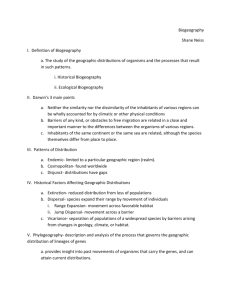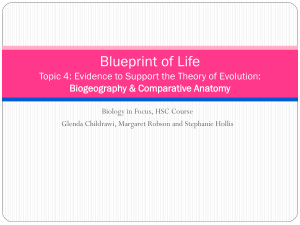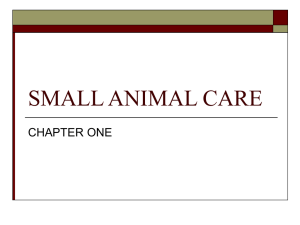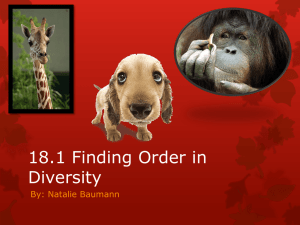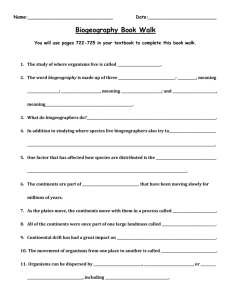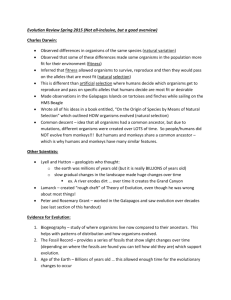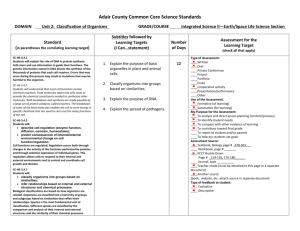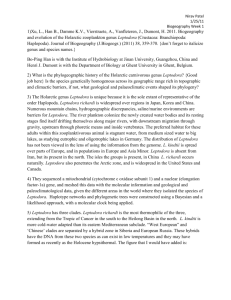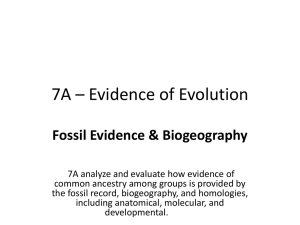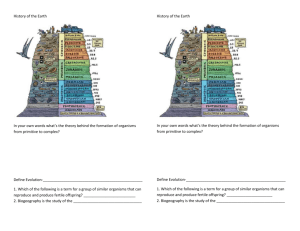Evidence for Evolution
advertisement
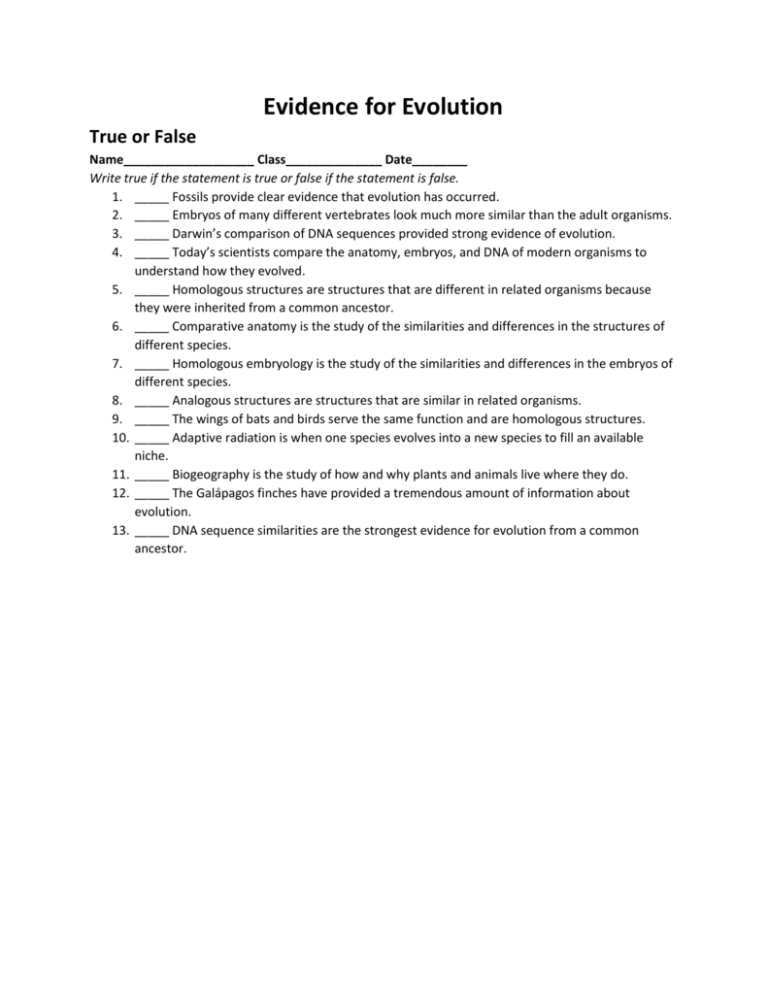
Evidence for Evolution True or False Name___________________ Class______________ Date________ Write true if the statement is true or false if the statement is false. 1. _____ Fossils provide clear evidence that evolution has occurred. 2. _____ Embryos of many different vertebrates look much more similar than the adult organisms. 3. _____ Darwin’s comparison of DNA sequences provided strong evidence of evolution. 4. _____ Today’s scientists compare the anatomy, embryos, and DNA of modern organisms to understand how they evolved. 5. _____ Homologous structures are structures that are different in related organisms because they were inherited from a common ancestor. 6. _____ Comparative anatomy is the study of the similarities and differences in the structures of different species. 7. _____ Homologous embryology is the study of the similarities and differences in the embryos of different species. 8. _____ Analogous structures are structures that are similar in related organisms. 9. _____ The wings of bats and birds serve the same function and are homologous structures. 10. _____ Adaptive radiation is when one species evolves into a new species to fill an available niche. 11. _____ Biogeography is the study of how and why plants and animals live where they do. 12. _____ The Galápagos finches have provided a tremendous amount of information about evolution. 13. _____ DNA sequence similarities are the strongest evidence for evolution from a common ancestor. Critical Reading Read these passages from the text and answer the questions that follow. Evidence from Biogeography Biogeography is the study of how and why plants and animals live where they do. It provides more evidence for evolution. Let’s consider the camel family as an example. Biogeography of Camels: An Example Today, the camel family includes different types of camels. All of today’s camels are descended from the same camel ancestors. These ancestors lived in North America about a million years ago. Early North American camels migrated to other places. Some went to East Asia. They crossed a land bridge during the last ice age. A few of them made it all the way to Africa. Others went to South America. They crossed the Isthmus of Panama. Once camels reached these different places, they evolved independently. They evolved adaptations that suited them for the particular environment where they lived. Through natural selection, descendants of the original camel ancestors evolved the diversity they have today. Island Biogeography The biogeography of islands yields some of the best evidence for evolution. Consider the birds called finches that Darwin studied on the Galápagos Islands. All of the finches probably descended from one bird that arrived on the islands from South America. Until the first bird arrived, there had never been birds on the islands. The first bird was a seed eater. It evolved into many finch species. Each species was adapted for a different type of food. This is an example of adaptive radiation. This is the process by which a single species evolves into many new species to fill available niches. Eyewitness to Evolution In the 1970s, biologists Peter and Rosemary Grant went to the Galápagos Islands. They wanted to re-study Darwin’s finches. They spent more than 30 years on the project. Their efforts paid off. They were able to observe evolution by natural selection actually taking place. While the Grants were on the Galápagos, a drought occurred. As a result, fewer seeds were available for finches to eat. Birds with smaller beaks could crack open and eat only the smaller seeds. Birds with bigger beaks could crack and eat seeds of all sizes. As a result, many of the small-beaked birds died in the drought. Birds with bigger beaks survived and reproduced. Within 2 years, the average beak size in the finch population increased. Evolution by natural selection had occurred. Questions 1. What is biogeography and what does it provide? 2. Why did camels evolve? 3. What is adaptive radiation? Give an example. 4. What did the Grants study? What did they observe? Multiple Choice Circle the letter of the correct choice. 1. Evidence of evolution includes (a) DNA sequence analysis. (b) the fossil record. (c) anatomical evidence. (d) all of the above 2. Which of the following is true about horse evolution? (1) Early horses were about the size of a fox. (2) Early horses had toes. (3) During evolution, their molars became covered with cement. (a) 1 only (b) 1 and 2 (c) 2 and 3 (d) 1, 2, and 3 3. Examples of analogous structures are (a) the tails of mice and rats. (b) the limbs of humans and apes. (c) the wings of bats and birds. (d) all of the above 4. An example of a vestigial structure is the (a) kangaroo pouch. (b) human tail bone. (c) cat forelimb. (d) all of the above 5. The strongest evidence for evolution from a common ancestor is (a) similar DNA sequences. (b) similar body structures. (c) similar embryological structures. (d) (d) similar fossils. 6. Island biogeography (a) provides information on the migration and evolution of the camel. (b) provides information on the migration and evolution of the finch. (c) provides information on the migration and evolution of the ape. (d) none of the above Vocabulary I Match the vocabulary word with the proper definition. Terms a. adaptive radiation b. analogous structure c. biogeography d. cladogram e. comparative anatomy f. comparative embryology g. DNA sequences h. fossils i. homologous structure j. paleontologist k. vestigial structure Definitions _____ 1. the strongest evidence for evolution from a common ancestor _____ 2. shows how organisms are related by descent from common ancestors _____ 3. structures that are similar in related organisms because they were inherited from a common ancestor _____ 4. scientists who find and study fossils _____ 5. structures that are similar in unrelated organisms _____ 6. provide clear evidence that evolution has occurred _____ 7. reduced structures that are no longer used _____ 8. the process by which a single species evolves into many new species to fill available niches _____ 9. the study of the similarities and differences in the embryos of different species _____ 10. the study of how and why plants and animals live where they do _____ 11. the study of the similarities and differences in the structures of different species Vocabulary II Name___________________ Class______________ Date________ Fill in the blank with the appropriate term. 1. Humans and apes are evolutionarily closely related, based on analysis of their ____________sequences. 2. Wings of bats and birds serve the same function and are ____________ structures. 3. Comparative ____________ is the study of the similarities and differences in the structures of different species. 4. ____________ demonstrate that during the evolution of the whale, the whale moved from land into the sea. 5. The human tail bone and appendix are ____________ structures. 6. ____________ structures are structures that are similar in related organisms because they were inherited from a common ancestor. 7. Comparative ____________ is the study of the similarities and differences in the embryos of different species. 8. Early North American camels migrated to other places, some crossing a land bridge during the last____________. 9. The forelimbs of all mammals have the same basic bone ____________. 10. ____________ who find and study fossils are called paleontologists. 11. Peter and Rosemary Grant studied Darwin’s ____________ in the Galápagos Islands. 12. The biogeography of ____________ yields some of the best evidence for evolution. Critical Writing Thoroughly answer the question below. Use appropriate academic vocabulary and clear and complete sentences. Describe how each type of evolutionary evidence help us understand the past. Provide an example. (1 paragraph per type of evidence)
